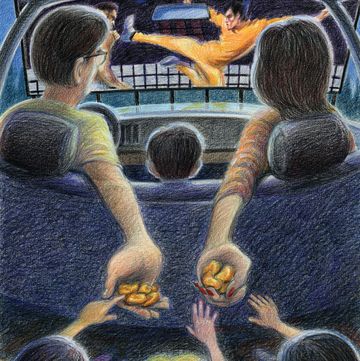This place is crawling with rattlesnakes, Emily Taylor tells me. But since rattlesnakes are masters of camouflage and generally don’t want to be seen, least of all by lumbering, heavy-footed mammals like us, we’re going to have to really look. “We’ll see if we get lucky,” she says. As we scan the acres of brush at Montaña de Oro State Park, just south of Los Osos, Taylor, a biology professor at nearby Cal Poly, in San Luis Obispo, tells me fun facts about rattlesnakes, like how they sometimes babysit their friends’ kids, and how they can live for more than 60 years, and how, no, they don’t want to bite you. All that stuff you’ve seen on TV, she says, is “BS.” We pass coyote brush and golden poppies. “Oh, there’s one,” Taylor says.
A gorgeous northern Pacific rattlesnake, one of seven species of rattlers native to California, is hiding underneath a small bridge. He’s brownish-black and about two and a half feet long, with tan spots that form banded stripes around his coiled body. His forked black tongue flicks up and down, up and down from out of his triangular head. “That’s a big one,” Taylor says.
I’ve seen rattlesnakes before, but nearly always in cages or in zoos. Being this close, out in the relative open, is an amazing experience, I tell Taylor. “I hear you,” she says. “I still remember the first rattlesnake I saw in the wild. It was a red diamond rattlesnake outside of Palm Springs, and it was like a spiritual experience for me.”
A lifelong athlete—she attended UC Berkeley on a soccer scholarship—Taylor spends a lot of time on these trails checking out rattlesnakes and knows all their favorite spots. She looks like other hikers or runners out here this morning: lavender Columbia hoodie and matching sweats, her long blond hair in braids coiled like her subjects under a tan Cal Poly cap. From the way they can pull molecules out of the air with their tongues to enhance their sense of smell to how straight-up badass they look, Taylor likes everything about rattlesnakes—she’s studied them for 25 years. But she understands the attraction only goes one way. “I have a strong emotional bond with rattlesnakes in general,” she says. “But they don’t have it with me. It’s not like me and my dog. Rattlesnakes don’t like people or show affection to us. They just don’t.”
No creature has come to symbolize the untamed nature of the American West more than the rattlesnake. The reptile has terrorized cowboys and greenhorns alike in countless westerns and adventure films (see “Reel Reptiles”). Some of the region’s greatest chroniclers have featured the snakes, from John Steinbeck (Cannery Row, “The Snake”) to Charles Portis (True Grit, with its den of writhing rattlers) to Larry McMurtry (his Pulitzer Prize–winning Lonesome Dove opens with a pair of blue pigs playing tug-of-war with a none-too-happy rattler). A small specimen spooks a cowboy’s horse in Frederic Remington’s iconic 1905 sculpture The Rattlesnake, while hordes of others slither through George Catlin’s 1852 painting The Rattle Snakes Den. Conscious of the animals’ totemic power and fearsome reputation, high schools throughout the West, from the Serrano Diamondbacks to the Rancho Mirage Rattlers, claim them as mascots.
In nearly every example, the rattlesnake is something to be feared. That reputation is not wholly unearned. The only animals that kill more people in the world than snakes are mosquitoes (via diseases like malaria and dengue fever) and those most lethal of creatures, other humans. “They are potentially the most dangerous wildlife in California,” Taylor says. “A bite from a rattlesnake is one of the most serious wildlife-induced injuries you can get.”
But again, Taylor notes, rattlesnakes don’t want to bite you. In fact, they don’t want to have anything to do with you. And yet, far from being the lone killers of popular lore, “rattlesnakes have really complex social lives,” Taylor says.
Many people assume that rattlesnakes don’t have social lives at all. But over the years, a handful of scientists and researchers like Taylor have turned that idea on its head. Gordon W. Schuett, an evolutionary and behavioral ecologist at New Mexico’s Chiricahua Desert Museum, has been studying the social structures and mating systems of rattlesnakes since the 1980s. At San Diego State University, Rulon W. Clark, a biology professor who often focuses on predator-prey relationships, has observed the close bonds that form between mother-daughter and sister-sister pairs of timber rattlesnakes.
Broadly speaking, such ongoing studies increase our knowledge about these misunderstood creatures. But researchers like Taylor have another goal in mind that goes beyond simple intellectual curiosity: if more people learned the truth about rattlesnakes—about how they have friends, and care for their young, and help cut down rodent populations—perhaps fewer people would go out of their way to kill them, out of either ignorance or sheer meanness. “We’re really trying to change people’s minds about rattlesnakes,” says Taylor. “If we can show a kid a snake in a nonthreatening way when they’re young, they will grow up to appreciate and respect them.”
Taylor even has a name for this. “We call it rattlesnake public relations,” she says. Along the trail, she’s used every opportunity to convert me, but I’m probably not an ideal candidate. As a lifelong lover of rodents and other furred creatures—over the years, I’ve had rabbits, fancy rats, hamsters, and guinea pigs as pets—I’m not a big fan of predators that could eat my little friends whole.
Organizations like the Humane Society, which champion more inherently lovable animals like dogs and cats, have a much easier task than rattlesnake advocates like Taylor. Snakes engender an innate and intense fear in humans and other primates, one that scientists believe may have roots in evolution. Dogs look lovable. Rattlesnakes, however, not so much.
About 250 miles southeast of Los Osos is Loma Linda University, where Chelsea Martin has been conducting research on rattlesnakes for several years. Petite and bespectacled, in a light blue T-shirt from the 2022 Biology of Pitvipers Symposium, Martin has the clear diction and cheerful, earnest manner of a born teacher. As an undergrad, she was doing summer research on snapping turtles when she caught her first glimpse of a northern water snake. “I was like, OK, I want to study snakes!” she recalls.
This afternoon, Martin is getting ready to rile up one of her subjects: a rattler inside a lidded plastic tub. Three electrodes attached to its body are connected, via long wires, to heart rate monitors. After giving it 30 minutes to settle, Martin releases two rubber band–powered PVC pipes affixed to a wooden contraption, and they strike the side of the tub with a loud whack, whack. A moment passes, and then the snake starts to shake its tail furiously. Despite the maraca sound in Hollywood movies, the rattle is more of a loud and steady buzz, easy to hear even from inside the closed tub. I ask whether Martin and her colleagues amplify the sound, so they can measure how long the rattling lasts. “No, that’s really how loud it is,” she says.
The study is a continuation of a project Martin began in 2020, when she tested snakes in three different environments: alone, with a short length of rope as a control object, and with another snake. Her research revealed that the snakes who had a companion to hang out with when the PVC pipes started thumping were much less stressed, based on their heart rates, than the ones who were alone or with a piece of rope. This first observation of “social buffering” in reptiles made headlines, from the reasonably accurate (the Washington Post’s “How Do You Calm a Rattlesnake? Give It a Friend, Scientists Say”) to the much less so (the New York Post’s “Misunderstood Rattlesnakes ‘Capable of Emotions,’ Love to Cuddle with Each Other, Study Finds”).
As groundbreaking as that initial study was, Martin still had questions: Could snakes socially buffer even if they weren’t physically touching? Would the results be different if the snakes were tested alongside snakes they knew, as opposed to strangers, as in the first study? In this latest round of trials, Martin is using a larger tub, so that the snakes have a choice not to lie on top of each other, to see whether they seek a friend. And she’s housing the snakes in pairs before the tests, to observe what effect friendship has on social buffering. “There’s a lot we don’t know,” she admits.
This article appears in Issue 27 of Alta Journal.
SUBSCRIBE
Martin is conducting the tests with Ben Streit, a second-year doctoral student, in a basement research facility that looks like most school labs, except that it’s filled with cages and cages of snakes. They get ready to place two friends in the tub. Martin uses a hook to try to guide one of the snakes headfirst into a clear plastic tube, but the animal, a southern Pacific about three feet long, isn’t having it; it’s wriggling around and rattling like crazy. “Some of them are easier to get in the tube than others,” she says. Once the snake is inside, Streit uses tape and conductivity gel to attach electrodes to its body, which the snake doesn’t enjoy too much either.
The researchers have the process down to a literal science, and for good reason. A bite from a rattlesnake can cause nausea, internal bleeding, and swelling of the mouth and throat; if it’s left untreated, within hours your organs can shut down and you may die. According to the California Poison Control System, rattlesnakes bite around 300 people in the state a year, but thanks to antivenom treatments, there are few deaths.
The second snake, a smaller, light gray southern Pacific, is more docile, going into the tube as if trained. “She’s a good girl,” says Martin. “She’s one of my favorites.” The researchers again wait for 30 minutes, the amount of time it takes for the rattlers’ heartbeats to return to normal. “All of this is very stressful for them,” Martin says. “They think I’m a predator, so they probably think they’re going to get killed.”
While we wait for the pair in the tub to calm down, we enter a small room next to the lab that, if you’re not partial to serpents, would give you the heebie-jeebies. But for snake lovers, it’s heaven. There are copperheads (not as venomous as some rattlesnakes, Streit says, “but still not a good time”) and sidewinders, with their signature desert crawl. There are southwestern speckled rattlesnakes and a western diamondback, whose species causes “the most snakebites in the U.S., because of their huge range,” Martin says. There are Gaboon vipers and green mambas, from sub-Saharan Africa. A venomous Mexican beaded lizard, cousin to the Gila monster, eyes me coolly. As I get closer to the glass to look at a red diamond rattlesnake (among the calmer types), an albino reticulated python peers out from the cage above me. “They’re the longest snakes in the world,” Streit says. “She’s probably around 10 feet long, but they can reach up to 30 feet.”
“Her name’s Banana Cream,” Martin says.
These snakes—unlike the 28 southern Pacific rattlers in Martin’s study—support the lab’s PR efforts. Researchers take them to local schools and churches, allowing people to handle the nonvenomous ones so they can appreciate their beauty. “If you can give people a more positive experience with snakes, maybe the next time they do encounter an animal, they might not be as afraid, or they might not choose to harm it,” says Martin.
“You don’t have to like them,” she adds. “But you should respect them enough to not kill them. We should be able to live with them in harmony. These animals were here before us, especially here in Southern California. And they’re not going anywhere.”
Little by little, I find myself falling for rattlesnakes, or at least understanding better why people might. Back at Montaña de Oro, Taylor tells me about the different PR strategies she uses to bring people into the fold. “You have to assess who you’re talking to, to see how they react to things,” she says. “If I’m talking to a rancher who has cut the heads off hundreds of rattlesnakes in their lives, my attitude is going to be very different from when I’m talking to someone who just moved out to an area and has rattlesnakes in their yard.”
When Taylor tells me this, I recall how my father, who raised chickens not far from Martin’s school in Loma Linda, once chopped the head off a rattlesnake with a shovel so it wouldn’t get at his birds (in a weird loop, my father went to Taylor’s school, Cal Poly, to study poultry on the GI Bill). And when I learn that rattlesnakes do feel pain long after their heads have been cut off, I remember, as a kid, peering inside a big tub at an illegal camping site along the Merced River and seeing a rattler that friends had beheaded the previous night, its body still making slow concentric circles inside. Both incidents happened decades ago, when people knew a lot less about rattlesnakes. But similar incidents continue to happen, something that Martin and Taylor hope to combat through their ongoing PR campaigns.
Taylor spots another rattlesnake, this one coiled up on the edge of the trail. We crouch down to look, so others do too. “Guys, there’s a snake!” a young girl yells. “Be careful,” her dad says. The rattler slinks away, leaving behind a perfect sandy circle in its wake. Taylor turns the chance encounter into a teachable moment. “It’s cool, huh?” she says to the girl. “See the little marks it left behind? It’s so adorable, right?”
For folks who want to see rattlesnakes but can’t make it to Montaña de Oro, or maybe don’t know where to look once they get here, there’s Project RattleCam. In 2021, Taylor launched the first-ever livestream of a rattlesnake rookery—a den where females gather in the summer to have their babies. For the past two years, the project’s camera was focused on a Central Coast den, home to 11 or so snakes. This year, it will stream 24-7 (thanks to new infrared cameras) from a rookery in northern Colorado, the remote, mountainous home of up to 2,000 rattlers. “It’s what we call a mega-den,” Taylor says. “It’s massive.” She and her team hope the rookery camera will provide them with answers to pressing questions, like what’s going on with all the babysitting? And why are male snakes hanging around a rattlesnake “nursery”?
Like the Central Coast rookery’s, the location of the Colorado site is a well-guarded secret. Even the researchers don’t like to visit. “Our presence affects their behaviors,” Taylor says. And then there are those who don’t like snakes as much as Taylor does to worry about. “If people knew where it was, they might go and kill all the snakes, or steal our camera,” she says. “Nothing good happens when people visit these spots.”
This May, Heyday Books will publish Taylor’s guidebook, California Snakes and How to Find Them, which features profiles of nearly 50 native species. The book will likely be a persuasive argument against still-popular events like rattlesnake roundups, held in places such as Sweetwater, Texas, where tens of thousands of visitors assemble to enjoy the spectacle of hundreds of snakes being slaughtered for their meat and skins. “For $10, a kid can come and skin the snake while it’s still alive,” Taylor says. “With any other animal, people would never stand for it.”
As far as rattlesnake PR goes, the global reach of Project RattleCam will be a previously unattainable godsend. Taylor imagines city kids who rarely make it into nature, or those with mobility challenges, or people outside the Americas being able to see rattlers in their own habitats, not just misrepresented on film. “Rattlesnakes are only in the Western Hemisphere,” says Taylor. “But they’re famous worldwide. When you think of the American Southwest, what do you think of? Cowboy boots and rattlesnakes. And we’ll be bringing the snakes to them.”•
Robert Ito is a journalist based in Los Angeles. He writes about film, television, and theater for the New York Times.














